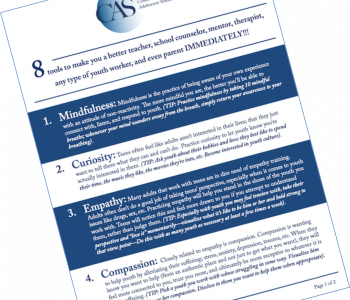

Sam Himelstein, PhD
Sam Himelstein is the founder and CEO of the Center for Adolescent Studies, Inc. He is passionate about working with youth and training the professionals that serve them.
6 Tips for Building Authentic Relationships with Adolescents
Working with teens can be tough. Anyone who works with adolescents knows that sometimes they test boundaries, become resistant, and can be very challenging. Teens can also be remarkable and amazing to work with. There is an inherent wisdom during the life transition period from childhood to adulthood that can show itself in many ways; artistic talent, kindness, camaraderie, and much more. Most of us who work with adolescents already know—whether we’re mental health, education, juvenile justice, or other professionals—that the relationships we form are the basis for our work. As a psychotherapist, I have personally witnessed the power of the relationship on many occasions. I have many colleagues in the fields of juvenile justice and education that can attest to this as well. Building authentic relationships with the young people we work with can be healing in and of themselves (i.e., give the youth a “relationally corrective experience,” that is, a healthy relational schema with adults) and contribute to better outcomes (e.g., youth engaging in therapy more deeply, putting forth more effort in school, etc.).
How do we build authentic relationships with adolescents?
Contemplate the authentic relationships in your life and I’m sure you can come up with a number of qualities that can be used with youth (I highly recommend this exercise). For now, review below 6 basic, but powerful, skills for building authentic relationships with adolescents (or anyone for that matter):
1) Listen.
Because of our inherent power differential and authority we are often in positions of telling adolescents what to do rather than actually listening deeply to them about their experiences and lives. To listen deeply to adolescents is to give them the time of day, both figuratively and practically. Practically if we actually take time to listen to them about their lives (however that may show up in your profession) they will view us as safe relationships and grow closer to us. Figuratively, if we orient ourselves toward a philosophy of being open to them (i.e., not just directing them), we will more likely be aware of potential leadership qualities. On both levels we provide a relationally corrective experience for adolescents: an adult actually gives them the time of day and this shifts the way in which they view adults in their lives.
2) Show your human side.
If we’re going to build an authentic relationship, we need to show up as our authentic selves. In order to do that, we need to, at some point, show the young folks we work with who we are. That means potentially telling them about ourselves and sharing our experiences. Most professionals are afraid to disclose things about themselves because they feel that information will get manipulated in some way. While that does happen at times, it’s much more rare than you think. So be you, disclose about yourself when you think appropriate, and show the adolescents you work with your human side. A good rule of thumb however is that before practicing self-disclosure, ask yourself the question, “is what I’m about to say in the best interest of the young person?” This puts you in a self-reflective state (so you don’t just blurt things out) and keeps the focus on the young person and their story rather than you, which is our professional obligation.
3) Set boundaries when needed.
If the young people you work with test your boundaries, or rather, when they test your boundaries, it’s important to set clear, appropriate, and healthy boundaries. Why? The short and simple answer is, it makes you trustworthy, reliable, and ultimately safe as a relationship. While most youth probably won’t explicitly ask for you to set boundaries, or consciously agree with what I’m writing here, they will respect it. When you do so you’re showing them that both the professionalism and safety of the relationship won’t be compromised. Especially for youth who are relationally traumatized, and who at times seek inappropriate relationships with adults or become manipulative or seductive, we need to set boundaries. This can be emotionally healing and corrective.
A good method for setting boundaries is the TAP method. T stands for take a breath. When a boundary needs to be set, oftentimes it can be uncomfortable. That’s when we need to manage our experience. So taking a breath stands for actually taking a breath, becoming present to our experience, and managing that experience in the moment. The A stands for acknowledge. That means acknowledge how you feel. This helps you manage your experience better. The second part of this is to acknowledge that a boundary needs to be set. It puts you in the state of mind where you’re reflective and know what you’re about to do. Finally, the P stands for proceed. That’s the actual engagement. For this, start with a question. Don’t just demand. Ask a question, even if it’s not directly related to the tested boundary: “hey, can we talk over here in private for a moment?” After you ask the question, calmly tell the youth your experience (a way to be human with them) and calmly set your boundary: “Can I ask you something? … Do you notice how when you engage in side talk in the class a lot of youth listen to you? … It tells me you may have a natural gift to present, or facilitate … the only thing is it’s tough for me to present my topics for the class when that happens. Is there a way for you to help me out and direct the energy in a positive way?
4) View resistance as protection.
Closely related to boundary testing, most of us who’ve worked with adolescents for even a short period of time know that at times they will be resistant; resistant to activities, to us as adults, resistant to a multitude of things. Resistance shows itself in the form of traditional resistance (“I’m not doing that”), to being humorous during a serious discussion/activity, to being detached, bored, and checked out. When this resistance arises, it is so easy and tempting for us as adults to take it personally. I don’t mean that we choose to take it personally, but that it’s natural for human beings to make things about themselves. And when we take it personally we can easily become unskillful and compromise the safety of the relationship. When we do not take resistance personally we have the opportunity to help youth become aware of their defense mechanisms and deepen in insight. In my practice the best possible solution I’ve encountered to not take resistance personally is to view it as protection. If you think of resistance like a defense mechanism, that is, something needs to be defended (i.e., anxiety, trauma, discomfort, etc.), and that in the moments when youth present with resistance they are defending or protecting themselves, it’s much easier to not take it personally. And again, when we don’t take the resistance personally, we can work with the youth and actually help them gain in self-awareness. For example, I’ve worked with many youth who’ve used humor in some way to cover up feelings of trauma and anxiety. In a group this can at times be very disruptive and frustrating. But when I think of what they’re doing as a way to protect themselves (against a discussion that may bring up sensitive material for example), I don’t let my ego get wrapped up in the experience. That makes it much easier for me to manage my frustration (which comes a lot less if I view resistance as protection) and actually engage the resistance in a skillful way (i.e., have an authentic conversation about it directly, or approach it indirectly like empowering the youth in leadership role in the group and exploring it later). I like to think of a pyramid of skillfully working with resistance: the bottom base is the view that resistance is protection, the middle layer is the ability to practice self-management when resistance arises in the moment, and the top layer is engagement, what we actually do or say when resistance arises. Each of these layers depends on the layer or skill below it and when practiced explicitly can help youth become more aware of their defense mechanisms, what they’re defending against, and make you less antithetical.
5) Learn basic counseling skills, no matter your profession.
This may be more a review for therapists, but for educators, group home staff, probation staff, and others working with adolescents, it’s important to have some basic counseling skills. I’m not suggesting you get training that will help you heal a youth’s trauma (that’s our jobs as therapists), but I do suggest you learn the basic conversational skills that will leave the youth feeling they’ve been heard, witnessed, and that you’ve been present. The OARS acronym represents some of the most basic (but powerful) counseling skills. O stands for Open-ended question. When you’re in a conversation with an adolescent, one way to keep the focus on him or her is to ask questions that will get them talking. These obviously aren’t yes/no questions, but rather questions that make them think and give you rich descriptions of whatever it is you’re asking; “tell me about what it was like to get your first A in school,” rather than “was it good getting your first A in school?” A stands for Affirmations. These are strength-based statements that affirm something positive about the young person and helps them remember to not always be critical of themselves; “I know you failed the high school exit exam, but you also showed strong work ethic and studied more than you ever have in the past. If you keep up that effort, I’m sure you’ll keep moving in the right direction.” R stands for Reflective statement. A reflective statement is when you direct the youth’s awareness to something in particular, usually a goal they have. For example if a youth fails his or her high school exit exam (as in the example above) and then begins to wallow in negativity of how he or she will never graduate high school, a reflective statement would be to remind them of the effort put forth; “I know it’s difficult to fail and it makes you want to give up graduating high school. Remember though, that this is the first time you’ve put in this much effort. Your goal is to graduate high school and in some sense at least, this is really the first time you’ve tried. If you keep putting forth this much effort, what do you think the result will be?” Finally, the S stands for summary. This simply means summarizing the conversation you’ve had with the young person. It shows them that you’ve been listening, and with all the OARS, contributes to the youth feeling heard, witnessed, and that an adult is giving them the time of day, all of which contribute to building an authentic relationship.
6) Practice self-care.
Self-care is probably the most important skill on this list. If we don’t take care of ourselves, we become fatigued professionally and can burnout. If we burnout, there is much more of a likelihood that we’ll end up leaving, and if we leave, that adolescent doesn’t get that authentic relationship in the first place. And especially for those of us that work with youth dealing with trauma and oppression, if we don’t practice self-care we are at risk for compassion fatigue (becoming numb to trauma rather than feeling compassion) and vicarious trauma (developing the symptoms we see in our adolescents). Self-care is a unique and personalized practice. For me, I practice mindfulness meditation almost every day. It helps me stay calm and manage my emotions skillfully. I also exercise a number of times per week and stay connected to things greater than myself; service, my family, the universe, etc. Regardless, I suggest choosing 2-3 “go to” self-care practices that you can rely on in times of need and practice consistently. This will help you show up more authentically, be more present, and be the best you possibly can be when working with adolescents.
—–
Listening, being human, setting boundaries, viewing resistance as protection, learning basic counseling skills, and practicing self-care are all simple yet transformative practices that can help you build authentic relationships with adolescents (and anyone for that matter). And, these practices are also just the tip of the iceberg. Again, I recommend engaging in the exercise presented in the second paragraph: sit down sometime and brainstorm all the qualities that comprise your authentic relationships in life. Maybe you’ll write down kindness, compassion, or a number of other qualities. Think of how you can explicitly practice them with the youth you work with, experiment, and report back (in the comment section below). As caring adults, the more of an intention we have to create real, authentic relationships (albeit professional), the more of a chance they will become reality.
If you’d like to join a practice community of life-minded professionals dedicated to ongoing training on development on trauma-informed care and building authentic connections with your students, clients, etc, join our FREE Training community here!
If you like this post, you might also be interested in the following posts about building authentic connection with those you work with:
3 Basic Counseling Skills for Working with Teens
3 Tips for Working with Resistant Teens
4 Qualities That Lead to Interpersonal Connection and Safety With Youth

